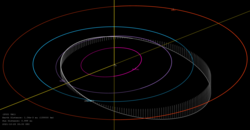Astronomy:2021 UA1
From HandWiki
Short description: Earth-crossing asteroid
 Orbit of 2021 UA1 | |
| Discovery[1] | |
|---|---|
| Discovered by | Catalina Sky Survey |
| Discovery date | 25 October 2021 |
| Designations | |
| 2021 UA1 | |
| Minor planet category |
|
| Orbital characteristics[3] | |
| Epoch 2021-Jul-01 (JD 2459396.5) | |
| Uncertainty parameter 6 | |
| Observation arc | 0.9 days[2] |
| |{{{apsis}}}|helion}} | 1.35 astronomical unit|AU (Q) |
| |{{{apsis}}}|helion}} | 0.6139 AU (q) |
| 0.98 AU (a) | |
| Eccentricity | 0.3750 (e) |
| Orbital period | 0.97 years |
| Mean anomaly | 312.8° (M) |
| Inclination | 10.19° (i) |
| Longitude of ascending node | 211.6° (Ω) |
| 66.27° (ω) | |
| Earth MOID | 0.000064 AU (9,600 km) |
| Jupiter MOID | 3.7 AU (550,000,000 km) |
| Physical characteristics | |
| Dimensions |
|
| Absolute magnitude (H) | 31.8[3][4] |
2021 UA1 is a small (~2 meter) near-Earth object that passed about 3047 km from the surface of Earth while passing over Antarctica on 25 October 2021 around 03:07 UT.[5][lower-alpha 1] Given the small size of the asteroid it only reached the brightness of Pluto at around apparent magnitude 14.[5] Since it approached from the direction of the Sun, it was not discovered until 4 hours after closest approach.[1]
The 2021 Earth approach lifted the orbit and increased the orbital period from 356 days to 413 days.[6] This changed it from an Aten asteroid to an Apollo asteroid.
| Parameter | Epoch | Period (p) |
Aphelion (Q) |
Perihelion (q) |
Semi-major axis (a) |
Eccentricity (e) |
Inclination (i) |
|---|---|---|---|---|---|---|---|
| Units | (days) | AU | (°) | ||||
| Pre-flyby | 2021-Jul-01[3] | 355.6 | 1.351 | 0.614 | 0.982 | 0.3750 | 10.19° |
| Post-flyby | 2022-Jan-01[6] | 413.1 | 1.525 | 0.646 | 1.086 | 0.4046 | 0.006° |
Notes
- ↑ Geocentric approach distance 0.000063 AU – 6378 km (Earth radius) is 3047 km. It passed within 4 degrees of the South celestial pole near closest approach.
References
- ↑ 1.0 1.1 "MPEC 2021-U95 : 2021 UA1". IAU Minor Planet Center. 2021-10-26. https://minorplanetcenter.net/mpec/K21/K21U95.html. Retrieved 2021-10-26. (K21U01A)
- ↑ 2.0 2.1 2.2 "Earth Impact Risk Summary: 2021 UA1". NASA/JPL Near-Earth Object Program Office. https://cneos.jpl.nasa.gov/sentry/details.html#?des=2021%20UA1. Retrieved 2021-10-26.
- ↑ 3.0 3.1 3.2 "JPL Small-Body Database Browser: (2021 UA1)". Jet Propulsion Laboratory. https://ssd.jpl.nasa.gov/tools/sbdb_lookup.html#/?sstr=2021UA1&view=OPC. Retrieved 2021-10-26.
- ↑ "2021 UA1 Orbit". Minor Planet Center. https://www.minorplanetcenter.net/db_search/show_object?object_id=2021+UA1. Retrieved 2021-10-26.
- ↑ 5.0 5.1 "Horizons Batch for 2021-10-25 03:06 UT". JPL Horizons. https://ssd.jpl.nasa.gov/horizons_batch.cgi?batch=1&COMMAND=%272021+UA1%27&START_TIME=%272021-10-25%2003:05%27&STOP_TIME=%272021-10-25%2003:09%27&STEP_SIZE=%271%20minute%27&QUANTITIES=%271,9,20,39%27. Retrieved 2021-10-26.
- ↑ 6.0 6.1 "Horizons Batch showing epoch 2021-Jul-01 and 2022-Jan-01". JPL Horizons. https://ssd.jpl.nasa.gov/horizons_batch.cgi?batch=1&COMMAND=%272021+UA1%27&TABLE_TYPE=%27ELEMENTS%27&START_TIME=%272021-07-01%27&STOP_TIME=%272022-01-01%27&STEP_SIZE=%276%20months%27&CENTER=%27@Sun%27&OUT_UNITS=%27AU-D%27. Retrieved 2021-10-26.
External links
- 2021 UA1 Close approach date: 2021 10 25.130000 (03 07 12.0) – MPC diagram using WebGL
- 2021 UA1 – Tony Dunn (Gravity Simulator)
- 2021 UA1 – David Rankin (Catalina Sky Survey)
- 2021 UA1 at NeoDyS-2, Near Earth Objects—Dynamic Site
- Ephemeris · Obs prediction · Orbital info · MOID · Proper elements · Obs info · Close · Physical info · NEOCC
- 2021 UA1 at ESA–space situational awareness
- 2021 UA1 at the JPL Small-Body Database
 |


